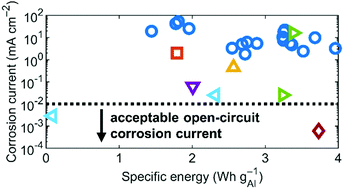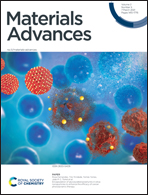Quantifying an acceptable open-circuit corrosion current for aluminum–air batteries†
Abstract
Primary aluminum–air batteries achieve impressive specific-energy values but suffer from poor shelf life due to corrosion of the aluminum anode in aqueous electrolytes. To solve this problem, researchers investigate numerous corrosion-mitigation strategies. Few rigorously compare the performance of these strategies, and most fail to define a technologically acceptable open-circuit corrosion current. To compete with commercialized zinc–air batteries, aluminum–air batteries need open-circuit corrosion currents less than 0.01 mA cmgeo−2, which we derive by performing a sensitivity analysis on a corrosion model reported here. By conducting a meta-analysis using reported aluminum–air cells, we find that certain ionic-liquid electrolytes and oil-displacement systems enable corrosion currents that meet this metric. In contrast, values for commonly reported aluminum–air batteries using alkaline electrolytes are orders of magnitude too high. Once the aluminum–air community focuses on advancing appropriate corrosion-mitigation strategies, laboratory findings may become commercially relevant.

- This article is part of the themed collection: Editor’s Choice: Beyond Li: Alternative battery chemistries


 Please wait while we load your content...
Please wait while we load your content...